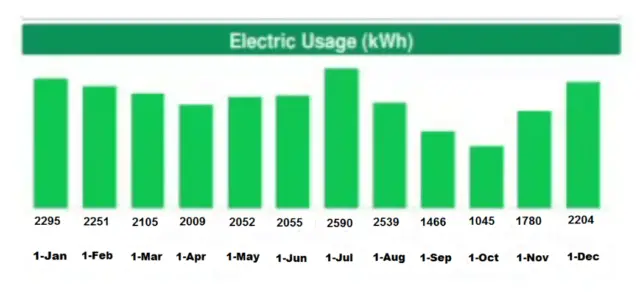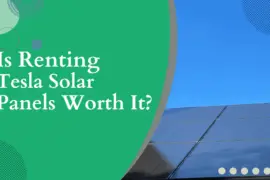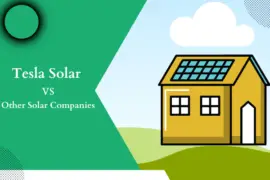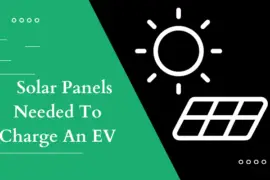Last Updated on May 30, 2023 by Rose Morah
If you want to find out how many solar panels you need to power your house, it is important to note that it is not the number of panels that matter but rather the watts (array size).
Solar panels come in many different wattages. This article will guide you through the process of calculating the solar array size needed to power your house.
The number of panels that you need will mainly depend on the following factors:
- Whether you want an off-grid or grid-tie system
- Where you are located
- How much power you consume annually
- How much power your home’s electrical system can handle
So, to help you decide, we are going to cover these factors in detail.
Related: How To Calculate The Solar Panels Needed To Charge An EV.
1. Do you want an off-grid or grid-tie system?
An off-grid system is not connected to your electricity grid. The power generated is stored in batteries for later use.
The Grid-tie system on the other hand is precisely the opposite. Your panels generate and store the electricity in the utility grid. Your solar is tied to your local utility grid.
The choice between an off-grid and a grid-tie system influences the size array your solar system will need for your house.
The following table below shows the differences between the off-grid and grid-tie:
| Grid-Tie | Off-Grid | ||
| 1. | Does not need a large solar installation system. You can install a smaller system | 1. | You will need to do a large solar system installation. |
| 2. | It has a lower initial investment cost. You can start small and then invest more in the future. | 2. | High initial investment. It is much more expensive compared to the grid-tie. |
| 3. | You will still be connected to your utility company. They provide power that your solar system cannot produce. They will also purchase the excess power that you produce (net metering). | 3. | You have no utility connections. This means that if your solar system goes down you will not have power. |
| 4. | The battery is not required. | 4. | You will need to have a battery bank. |
| 5. | You will still have a monthly utility bill. | 5. | No monthly utility bill |
It is also important to point out that, you do not necessarily have to start with off-grid especially if you are on a tight budget.
You can start with grid-tie, which is less expensive compared to off-grid, then switch to the off-grid in the future when you are ready.
So, if you do decide to go with either of the two, be aware that off-grid will need more solar panels compared to grid-tie.
See also:
Tesla Solar VS Other Solar Companies: Is Tesla Solar Worth It?
Is Renting Tesla Solar Panels Worth It?
2. Where are you located?
Your location plays a great role in determining how many solar panels need to be installed on your property.
Based on your location, the following factors affect the size array you will need:
- Solar hours per day
It is important that you find out how many hours in a day you are able to get maximum sunlight depending on your location.
Some states get an average of 5-6 hours of maximum sunlight a day, while others get fewer, about 3 hours in a day (of course depending on the season).

The data provided above is the calculated annual average sun peak hours.
From the map, New Mexico and Arizona receive the highest peak sunlight hours throughout the year while Washington and Wisconsin receive the least.
This means that if you are in a location that gets fewer peak hours of sunlight then you might need to add more solar panels depending on your electricity consumption, to maximize your energy production.
On the other hand, if you live in a location that gets more peak hours of maximum sunlight, you will need to consider your daily energy consumption.
Having many solar panels in this case may lead to wasted energy because they could be producing more than the energy you consume on a daily basis.
| You need to find out the amount of sunlight you get monthly to size your solar system based on the month that receives the highest and lowest sunlight. |
- Weather conditions
Living in locations/countries that experience longer winter seasons affects the size of the solar array that will need to be installed.
Some countries in Europe are cold almost throughout the year. Most countries in Africa and some states in the United States experience more sunny days throughout the year.
If you live in areas that have long cold seasons throughout the year, I recommend maximizing solar panels and batteries, to increase solar panel efficiency and be able to enjoy solar energy during these seasons.
- Latitudes
Whether you are located at the lowest latitude or the highest latitude, affects the number of solar panels needed to be installed at your home.
That being said, the lowest latitude gets more solar energy while the highest latitude gets lesser solar energy.
When evaluating your location, you can use The National Renewable Energy Laboratory (NREL) online resources to map the solar radiation. It will help save you time. |
| See also: Best EV Home Chargers(EVSE) According to EV Owners & Experts. 7 Things to Consider Before Installing an EV Home Charger (EV Home Charger Installation). |
3. How much power do you consume annually?
To find out how many solar panels you should install in your home, you first need to know how much power you consume annually.
There are two main ways to find out:
- Do some calculations (I’ll show you how).
- Use your electricity bill records (simplest way).
Let’s start with the simplest way.
Using your electricity bills
- Step 1
Use your annual electricity bills to determine how much electricity you consume on a monthly basis.
This should be something that looks like this:

- Step 2
For example, let’s assume your annual electricity consumption was 24000kWh/yr and your optimal payoff on the grid-tie system is 50%.
Consumption x % Target = Array Production Target
24,000 x 0.50 = 12,000kWh
This means that when you are designing your system, you will need to go for a system that is around 12,000kWh.
This will not only help you get a size array that meets your consumption needs but will also help optimize your return on investment.
- Step 3
Go to pvwatts.nrel.gov for better electricity production estimates, based on your location and other factors, and compare your step 2 results.
But when it comes to off-grid, you may need to do more calculations or leave it to the solar installer.
So, if you want to DIY the following are the steps to take to help you figure out what size array to install and the size of the solar battery to buy.
- Step 1 – Find the total home energy consumption.
You will need to find the total energy consumption for all your household equipment. To get this information, you can check labels, the equipment’s manual, or just visit the manufacturer’s website.
Remember to include your light bulbs, laptops which most people easily forget to add.
NOTE: The energy consumption is usually measured in kilowatt-hours or watt-hours per day.
For example, let’s assume you use your laptop 8 hours a day and consume 100 watts.
Consumption x hours used per day = Total energy consumption
100 watts x 8 hours = 800 wh
- STEP 2 – Find out the size of battery you need for your power consumption needs.
You will need to find out the days of autonomy (days when the batteries are supplying power without charging).
Days of autonomy are equal to the backup storage which maybe 3 to 5 days.
NOTE: Days of autonomy are the days when the sun is not at its peak. This is mostly on cloudy or rainy days.
This means that you will need to have backup power to power your house during the period when you are experiencing reduced output on your solar system.
We will apply the formula from our previous example to determine the size of the solar battery that you will need to get:
Total energy consumption x days of autonomy = usable size of your battery
We will give ourselves 3 days of autonomy.
800wh x 3 days = 2400wh (total usable) size of our battery.
This means that you will need to get a battery size of 2400wh.
However, if you live in a very sunny location, you can go for a lesser size, like an 800wh battery. Why?
Because you do not need the 3 days of power backup because even on bad days you will still be able to generate enough power for your home
It is also worth noting that, to get the days of autonomy that best suits you, you will need to know how much power you would like to back up and for how long.
Some people do not back up their entire house. They instead just consider the power that will be able to keep their fridge and lights on. This is to reduce the cost of batteries when installing solar at home.
| NOTE: Lead battery DOD only uses half (50%) of the battery rated capacity while Lithium battery DOD uses 100% of the battery rated capacity. For example, A 1000wh lead battery will deliver 500wh while a 1000wh Lithium battery will deliver 1000wh. Lead batteries usually have a lower upfront cost compared to lithium batteries however, lithium batteries have a longer lifespan. |
When getting a battery, I would like you to keep in mind that temperature can affect the battery capacity.
At lower temperatures, especially during the winter seasons, most batteries have lower efficiency. Therefore, I suggest taking that into account a 1.50 factor when choosing the size of the battery.
- STEP 3: Figure out what size solar array you will need to charge the battery in one day.
From the above example, we found that we needed a battery size of 2400wh. We will need to factor in the battery size and know the number of hours you get good sunshine in order to determine what size array we should install.
Use this formula;
Battery size ÷ 5 hours = solar size array
2400wh ÷ 5 = 480w
In my case, this means that I will need an array that is a minimum of 480w in size. However, this should not limit you, if you have space I recommend getting more, like 600w.
This is because a broader solar array makes a more reliable system.
| NOTE: Your solar array size will also depend on how frequently you will be running the battery during off-peak periods. |
4. How much power can your home’s electrical system handle?
You have figured out what size array you want to be installed, what’s next?
In most cases, how much your home’s electrical system can handle could limit you when it comes to the solar panel size array you would like installed.
Sometimes, you may need to upgrade before installing the solar, however, at times this may be impossible because of other reasons, like buried lines, and e.t.c
To help you to find out how much power your home’s electrical system can handle, you will need to check what your utility lines and main panel are rated for.
Your installer should be able to guide you.
Be sure to check out our article about what to know before installing a home solar system. It has tons of information about everything you need to know before installing a home solar panel.
Two things you need to know
- What size solar charge controller will you need to charge the battery and solar array?
To find out what size solar charger controller you need, you need to use the below formula:
Battery Size ÷ the size of solar array = size of the solar charge controller
Whatever size you get after calculating, for example, let’s assume you get 50 amps, I would recommend you go for a higher amperage for more efficiency.
So, in this case, instead of 50amp, I will get a 60 amp controller.
| PRO-TIP If you have a large solar array and a large solar charge controller, increasing the battery voltage will decrease the cost of the system. |
- How many hours will it take to charge your electric vehicle (EV) battery with a DC-DC charger?
You will use this formula;
Solar battery size ÷ (DC-DC Charger (amps) x batter voltage) = hours it will take to charge.
Let’s say, I have a 40 amp DC-DC, 12volts (battery voltage), and a 2400wh battery.
40amp x 12 = 480w
2400wh ÷ 480w = 5 hours
This means it will take 5 hours for the DC-DC charger to charge the 2400 battery.




